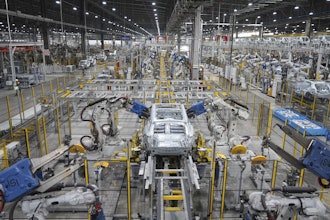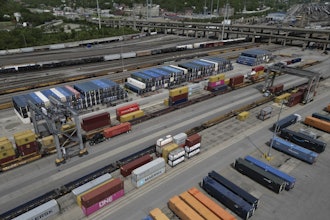
The manufacturing industry sits at the intersection of physical production and intricate global logistics networks. For decades, supply chain and distribution operations have relied on a patchwork of enterprise software, manual decision-making and reactive planning to get goods from production lines to end customers.
Logistics challenges can be devastating for manufacturers. Just-In-Time (JIT) operations have made manufacturers highly cost-efficient, but at the risk of being acutely vulnerable to costly unexpected downtime due to upstream supply issues. In addition to financial damage, downstream logistics issues can cause substantial reputational damage if delivery deadlines aren’t met.
One of the primary challenges for manufacturers is a lack of supply chain transparency, but visibility into the data alone isn’t a complete solution. With data sources ranging from suppliers, customers and third-party service providers, to inventory and production schedules, there is a massive volume of disparate information. Even with better insight into this supply chain data, analyzing it for trends and discerning the necessary actions to take is crucial.
Laying the Data Foundation for AI at Scale
Traditional manufacturing logistics rely on a mix of Enterprise Resource Planning (ERP) systems, Warehouse Management Systems (WMS), Transportation Management Systems (TMS), procurement and sourcing platforms, as well as spreadsheets, paper documents and human decision-making loops. Data is typically siloed in different areas, resulting in delays in information sharing and the ability to make informed decisions.
The first step in optimizing supply chain data management and analysis is to create a unified data architecture. Typically, this is centered on a “data lake” or “data lakehouse” that ingests data from disparate sources and ensures that it is contextualized, secure and has a clear “data lineage” of its source and transformation.
Historically, the process of unifying data was facilitated by Electronic Data Interchange (EDI) interfaces that enable the automated exchange of business documents between different computer systems, replacing manual, paper-based methods with electronic communication.
As the unified data lake is expanded, it extends from internal production metrics (OT systems, IIoT sensors), inventory levels, sales forecasts and customer orders, to external shipping and transit data, supplier lead times and disruptions, and other external signals (e.g., weather, port congestion, economic indicators).
This vast amount of data can provide decision-makers with incredible levels of transparency and insights. Still, complex, time-sensitive data is also challenging to report and to use to make decisions. That’s where AI can analyze and do pattern recognition, creating substantial value for manufacturers.
Extracting Insights Through Predictive and Prescriptive Analytics
The first step in implementing AI is understanding the organization's needs and requirements. Some use cases can utilize purpose-built solutions that are essentially “plug-and-play.” Other use cases may require some customization of a boxed solution tool, while the most complex use cases necessitate purpose-built solutions.
Off-the-shelf solutions offer quick wins and are ideal for common, well-understood use cases. These systems often integrate with standard ERP or TMS platforms, requiring minimal customization.
However, complex environments with unique workflows, legacy infrastructure or multi-modal logistics typically demand bespoke AI solutions. Once needs are identified and solutions have been chosen, AI insights can scale from predictive analytics to prescriptive analytics, and eventually to agentic guidance and automated actions.
Predictive analytics utilizes pattern recognition and historical data to forecast what is likely to occur, facilitating informed decision-making. Some examples of predictive analytics include:
- Demand Forecasting: Using machine learning to predict sales volumes across SKUs, channels and regions.
- Inventory Forecasting: Projecting stockouts, overstock risk and safety stock needs.
- Lead-Time Prediction: Estimating delivery times based on supplier performance, shipping conditions or port delays.
- Disruption Detection: Using anomaly detection or external event monitoring to flag potential delays or risks.
Prescriptive analytics utilizes predictive forecasts to enable AI models to recommend actions that optimize decisions based on target metrics. Some examples of prescriptive analytics:
- Order Allocation: Identify where to source parts or raw materials based on cost, risk and lead time.
- Dynamic Routing: Real-time optimization of delivery routes using the relevant data.
- Production Replanning: Adjusting production schedules in response to late shipments or early demand surges.
- Shift Scheduling: Aligning labor and equipment availability with predicted inbound/outbound flows.
While prescriptive analytics provide decision-makers with critical supply chain suggestions, agentic systems evolve beyond manually executed prescriptive analytics to real-time monitoring, augmenting decision-making with active alerts and the associated prescriptive suggestions.
Agentic systems can learn from feedback and adjust over time. Once proven, these systems can be fully automated, making decisions based on defined goals. Agentic AI can place or adjust orders based on supplier performance or shipping timeframes, optimize stock balance across warehouses, optimize logistics routes, or simulate “what-if” scenarios to update contingency plans.
Requiring robust integration across all levels of an organization, agentic systems bring autonomy to AI analysis, which can optimize supply chains both upstream and downstream for an organization.
Artificial Intelligence is reshaping manufacturing supply chains, from forecasting and planning to execution and delivery. However, success requires more than simply installing new software. It demands unified data, cultural change and phased implementation.
Manufacturers that start small, with clean data and clear goals, can build toward a future where logistics decisions are made in milliseconds, executed autonomously and constantly optimized for cost, efficiency and resilience. The era of opaque, unoptimized logistics is coming to an end. The age of the intelligent, adaptive supply chain is just beginning.
With more than 25 years of experience, Steve Blackwell is Head of Manufacturing Center of Excellence, Industry Specialists & Solutions at Amazon Web Services.






















